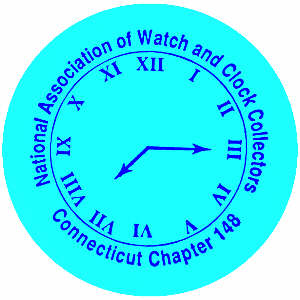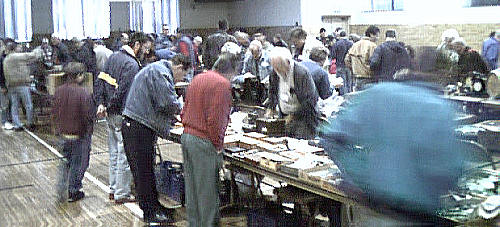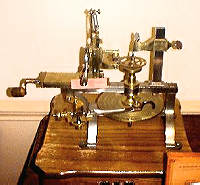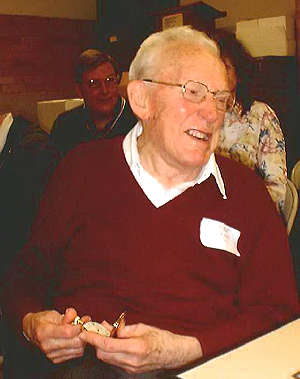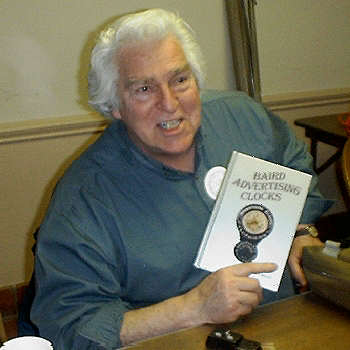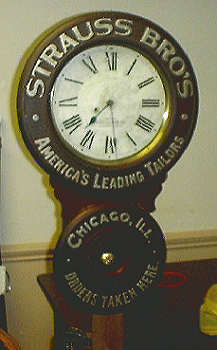|
|
Connecticut
|
Meetings PastMeeting Highlights - November 18, 2000 Connecticut Chapter 148's November meeting was held on Saturday, November 18. The meeting featured mart, raffle and technical presentation.
Items spotted at the mart included: a Seth Thomas miniature ogee shelf clock with rosewood case, original 'pancake' movement, hands and reverse glass painting of a dog; a Waltham watch ca. early 20th century; and an Ansonia 'Royal Bonn' shelf clock.
In addition to an impressive array of horological skills and accomplishments, for those of you who have never met Don, he is a very personable guy and a lot of fun to talk to! The topic of Don's presentation was 'Restoration Tips and Techniques for Wooden Clock Movements'. He began by outlining several vital but commonly neglected restoration measures, taking care to explain what should and shouldn't be done in each instance and why. For example, it is an essential first step in any wooden movement restoration project to examine pillar posts for loose connections with back plates. Pillar posts must be secured in order to eliminate twisting of plates and movement when the clock is wound and run. This simple measure greatly reduces the potential for a myriad of problems to occur attributable to excessive stress during operation of the clock. According to Don, pulling out pivot wires is a serious mistake. Early production techniques were not as precise as those practiced by the better brass movement makers. Consequently, arbor wires often do not run dead center and the wires may be bent with respect to the internal arbor centerline. Therefore, it may be next to impossible to reinstall a pivot wire in the original hole within an arbor. The need to install wooden bushings often occasions consternation in the inexperienced repairer. However, according to Don, the procedure is relatively simple. Using beautifully handmade materials to illustrate diagnostic and installation steps, Don explained that bushings are readily made from cherry wood using common plug hole cutters. After drilling a hole to receive the bushing, it is glued in from the back of the plate. Care should be taken to avoid centering errors attributable to shadows cast by the drill press. After drilling, the pivot hole is prick punched and reamed. Bushings should not extend the full depth of the plate; the back side of the pivot hole is finish drilled a little larger to avoid pivot hang up on the slightly rough surface. Finally, Don reminded us that wooden bushings should never be oiled! Each arbor should be spin-tested separately between the plates to evaluate excessive end shake. Testing progresses by adding adjacent wheels one at a time until operation of the entire train is tested in position. Time and strike trains should be tested separately. Getting into the habit of stepwise diagnostic testing saves much time trying to pinpoint problems when the movement is back together. Don provided a practical approach to many other repair problems, including but not limited to: badly soldered verge pivot holes; loose crutch wires; making slip sleeves for hour hands (hint: secure the hour hand on a wooden block with several nails before drilling in order to avoid a trip to the emergency room for stitches); replacing ivory bushings (Don recommends replacing them with bushings made from dogwood rather than bone, as the wood is appropriately light-colored and takes glue more effectively, resulting in a sturdier repair); and replacement of broken teeth and pinion leaves. Interestingly, Don's techniques with respect to the latter typically involve bamboo, square toothpicks and Bondo! Much to the audience's amusement, Don passed around a movement he had once received for repair in his shop. This unfortunate specimen suffered many of the indignities Don had recently counseled against, and several more we would not have thought of. Neighbors seemed to relish pointing out hitherto unremarked upon technical improbabilities to one another! Aside from the odd frustration in dealing with the arcane, the unforseeable and the unrestorable, Don acknowledged that his chosen career generally beats the alternatives. We think he has a point. We would like to thank Don again for generously sharing his time and expertise. And for those of you who haven't seen it, be sure not to miss the sampling of Don's handiwork on permanent exhibit at the American Clock and Watch Museum in Bristol! * * *Meetings PastMeeting Highlights - September 16, 2000 Chapter 148 met on Saturday, September 16. Meetings continue to be well attended. September's meeting featured mart, silent auction, raffle and workshop. There was found much to delight the mind's eye! Objects spotted at the mart tables included an Adler 11" disk music box with 25 disks (ca. turn of the century), exhibited by David Opal; several Waltham watches; a Standard Electric slave clock ca. 1930; and several Mission style clocks. George Bruno exhibited a fine, handcrafted pillar and "whales' tails" scroll clock with a wooden cutout plate movement based on the Eli Terry movement designated Type 1.111 (reference Bulletin of the NAWCC, October, 1980). The clock is the first of a series George plans to build. Harry Blair of New Jersey and Mel Smith of Katonah, NY, teamed to present a workshop entitled "The Watchmaker at His Bench". To illustrate their lecture, Harry and Mel in turn demonstrated an array of arcane-looking devices dating from the eighteenth through the early twentieth century. Harry's and Mel's personal collections of antique watchmaking tools furnished the materials for this extraordinary presentation.
For those interested in further information on the subject, Harry and Mel recommend a total of five short books on watchmaking tools written by Ted Krumm of northern Florida. Ted also maintains a private museum which is reportedly open to visitors who call ahead. (On a cautionary note, the author is unable to confirm the spelling of Ted's last name at this time.) During the presentation, Mel candidly confided that at time of purchase of many of the objects in his collection, neither he nor the seller was sure what the object actually was. We were pleased to have the opportunity to share these friends' contagious enthusiasm and joy of discovery in their research and collaboration. * * *Meeting Highlights - July 15, 2000 Connecticut Chapter 148's July meeting was held on Saturday, July 15. Our guest speaker was Chris Bailey, horologist and historian, curator and director of the American Clock and Watch Museum, Bristol, CT. Chris is well known as an author, for example, of the book entitled Two Hundred Years of American Clocks and Watches (Prentice-Hall, Inc., 1975), and of numerous articles appearing in horological and historical research journals. Chris presented a history of the Atkins family of Connecticut clockmakers, with all of their many partners. The firm was active beginning in 1817 and continuing until 1882. It was George Mitchell, brother-in-law to Irenus, Rollin and Avery Atkins, who first saw profit potential and influenced the brothers to add manufacture of clocks to their existing production of wood-turned faucets, horn combs and awl hafts. The Atkins family eventually made many styles of clocks beginning with wooden movement types and progressing through subsequent years of rapid technological advancement to wagon spring powered models, regulators, and thirty-day "equalized spring" types with rolling pinions. In doing so, the family and their descendents collaborated with many famous and not-so-famous Connecticut clockmakers including (but by no means limited to) Chauncey Jerome, Joseph Ives, Elias Ingraham, Adna Whiting, Orsamus Allen, and Samuel Merriman in business ventures which sometimes succeeded but often failed. The family's clockmaking history is a chronicle of rapidly changing economic circumstances and misadventures, leading to a large number of dissolutions and reorganizations of the firm. The Atkins' clock companies suffered chronic underfunding and never employed greater than forty-five persons at a given time. The factory buildings located near the Pequabuck River in Bristol survived near demise by fire many times attributable to the close proximity of stoves, boilers, sawdust, oils, and other combustible materials used in the manufacturing processes. Irenus Atkins, who generally led the firm in all its undertakings, died in 1882. The old factory finally succumbed to fire in 1894. Prior to 1996, the American Clock and Watch Museum neither possessed nor was aware of the existence of any Atkins Company trade catalogs. That year, a couple visiting the Museum brought with them a family heirloom Atkins clock. Kept with the clock since the day it was purchased was a hitherto unknown Atkins Clock Company trade catalog dated 1873 and a price list dated 1876. Before the couple left, they generously donated both clock and catalog materials to the Museum to enable others to access, study, enjoy and appreciate them as they did. A great story! * * *Meeting Highlights - May 20, 2000 Connecticut Chapter 148's May meeting was held on Saturday, May 20. Attendance was somewhat lighter than usual, possibly attributable to damp and dreary weather. However, those who did attend were afforded the pleasures of viewing fascinating objects, glimpses of history, stimulating conversation, good company and fine refreshments. Objects spotted at the May mart tables include a Swiss Amedee Paillard music box ca. 1870 - 1890, 9 x 2" cylinder (plays eight airs); a Jacot pivot polishing lathe; several Horolovar clock repair kits for 400-day clocks; fine watches and watch parts; and a number of ship's bell clocks. Members David and Sandra Opal brought photographs of several of David's impressive tower clock repair and restoration projects. The May meeting featured a presentation by a venerable horologist and historian, our own chapter member Dana Blackwell, FNAWCC. Dana's background in horology is extensive. He served as president of the Howard Clock Products Company of Waltham, MA through the 1970's. As director of the American Watch and Clock Museum in Bristol, he was involved in several exhibits and overhauled many of the museum's clocks. He is the author of numerous articles on technical and historical topics appearing in a variety of publications, including the NAWCC Bulletin and Antiquarian Horology. Most recently, Dana assisted the Bruce Museum in Greenwich in their exhibit on time, technology and art in honor of the millenium. We expected the subject of Dana's presentation to be Howard watches. However, it soon became apparent that he did not wish to be constrained to the subject of Howard watches. Dana has a lot to offer. Remarking gently that he was puzzled at being asked to speak about watches, Dana proceeded to reminisce on the subject of Edward Howard's manufacturing enterprises and products, including a generous sprinkling of clocks. Accompanying the talk with what can only be termed an extraordinary collection of slides, he spoke in a soft voice of some of the wondrous objects he had seen, places he had been, and modestly of some of the work he had done. Edward Howard was born in Hingham, MA in 1813. He served an apprenticeship in clockmaking with the Willard family of Roxbury. According to the late George E. Townsend ("E. Howard & Co. Watches", Heart of America Press, 1982), watches engraved "E. Howard & Co." were made in Roxbury, MA between 1858 and 1903. Prior to 1858, Edward Howard was briefly involved in watchmaking in the vicinity of Boston with partners Davis and Dennision. Dana once owned a painting which depicted Edward Howard's original (earlier) foundry in Hingham. The above reference states that Edward Howard retired from the watch business in 1883 and died in 1904. Dana explained that Edward Howard also received training as a balance maker. The original foundry in Hingham which existed prior to 1840 and the later factory sites produced surprisingly diverse product lines including clocks and balances. At that time, laws governing standard weights and measures were relatively new. Therefore, it can be hypothesized that the firm was functioning at the forefront of technology at its time.
Dana Blackwell continues to contribute generously of his time and extensive knowledge and experience in the field of horology. Our readers may recall that Dana recently teamed with chapter members Jim Gardener, Jerry Valenta and Chris Locke to lead the Edmond Town Hall Clock restoration project. As such Dana was responsible for overhauling the clock's mercury pendulum. For those readers who have never attended a Chapter 148 meeting, there are always a few surprises. Sometimes a veritable delight. * * *Meeting Highlights - March 18, 2000 Connecticut Chapter 148's March meeting was held on Saturday, March 18, Edmond Town Hall, Newtown , CT. Attendance was very good. The meeting included both mart and silent auction. The Works-in-Progress table featured a wooden clock movement made by chapter member Everett Herbert, who consulted with members regarding final adjustments to meshing of gears in the strike train. Everett brought along the plans and specifications from which he built the clock to demonstrate deficiencies in the plans, which he has by now completely redrawn! A most delightful feature of this clock is the variety of woods used in its making: much of the wood consists of pieces given by friends over the course of many years. Works-in-Progress also included an Ingraham "Dew Drop" calendar timepiece. An unidentified owner bought it knowing it was missing something, but wasn't sure exactly what. Jerry Valenta looked at it and said all it needed was the wooden bezel and glass, and that he had an identical clock hanging in his kitchen! The two of them will get together with the goal of planning appropriate restoration. Lastly, the table contained a Silas Hoadley quarter column short drop transitional clock given to Jim Katzin by his father. When received, the clock had a Gilbert gingerbread movement in it and a relatively recent mirror for the lower glass. A diligent search turned up the original ivory bushed movement, the clock's feet, splat and one of the plinths with a return. The clock's exterior finish was bubbled all over, but painstaking cleaning with Kotton Klenser and #0000 steel wool revealed the original heretofor hidden stenciling on the splat. Jim plans to build replacements for the missing plinth and return, plug recent holes in the dial and clean up the rest of the surface to reveal the stenciling on the quarter columns. He plans to replace the mirror with a reverse painted lower glass based on a similar Hoadley transition piece. Our guest speaker was Jerry Maltz, chapter member and author of a recent (and Jerry's first) book entitled Baird Advertising Clocks. Unfortunately, I arrived a few minutes late for the talk, unintentionally missing the first few minutes of the talk. Consequently, I can't add much about Jerry's background to what is described in the book. However, after several minutes it became clear that Jerry has plenty of: well, background!
Jerry assembled his collection of approximately eighty Baird clocks over the course of the past twenty-five years. Accompanied and warmly supported in his quest (as well as in production of the book) by family and friends, Jerry located and brought clocks from all over the United States, Canada, England and Ireland. His talk offered not only insight into the history and technical aspects of Baird clocks, but also into the rewards and tribulations of an avid and focused collector. Baird advertising clocks were manufactured in Montreal, Canada as early as 1887. Subsequently, the factory was moved to Plattsburgh, NY where production ceased in 1895. A few Baird clocks were manufactured in Chicago in 1897. The book contains a brief biography of the manufacturer Edward Payson Baird, a history of the clocks' manufacture and detailed information regarding the clocks' construction, doors, cases, labels, movements, dials and pendulum bobs. It is profusely illustrated with color and black and white photos from Jerry's collection. The information provided in the book is entertaining and of interest to collectors of both clocks and advertising memorabilia. Copies are available directly from Jerry. -Mary Jane Dapkus & Jim Katzin * * *Meeting Highlights - January 22, 2000 Connecticut Chapter 148's tenth anniversary meeting was held on Saturday, January 22, 2000. There were one hundred and thirty preregistered attendees. Despite a day in which temperatures did not attain double positive digits, overall turnout was very good with many registrations received at the door. Our January meeting traditionally does not include a guest speaker, this one not excepted. However, over the usual excitement associated with the mart, we discussed plans for upcoming chapter activities and projects (more on these to follow). As befits the first meeting of a new year, the Works-in-Progress table contained two projects in early planning and beginning stages. Member Craig Kazemekas brought a beautiful yet mysterious carved slave-type cherrywood clock case. Craig sought and received information as to appropriate restoration of missing parts. However, the manufacturer of the clock remains unidentified. We look forward to seeing this interesting project again as it progresses! Member Don Bruno brought to the table an unusual early diminutive "convex" bevel clock case in unrestored condition. The mirrored case retains its original Silas Hoadley, Plymouth, CT "Timepiece and Alarm" label. Don has recently begun reconstructing the clock's wooden alarm timepiece movement from drawings and specifications of the original. Furthermore, he plans to repair damaged veneer and to undertake construction and decoration of a dial. Stay tuned (or better yet, attend our next meeting) to learn more about this ambitious project as it unfolds. The following is a sample of the items which were offered at the mart: a Sverre Dahl tower clock movement (Norway, 1999); an early gear depthing tool; a Tillery's "Little Janitor" alarm clock with patent dates of 1915 and 1917; the original brass sign which hung outside the New Haven Clock Company General Office and Salesroom formerly located on Chapel Street in New Haven, CT which ceased operation ca. 1940; and a Welch Spring & Co., Forestville, CT calendar timepiece which indicates not only time, days of the week, months of the year, and phases of the moon, but also times of sunrise and sunset in New England! There were numerous other interesting clocks, watches, parts and books in addition to those mentioned. For those have never attended a Chapter 148 meeting, the Edmond Town Hall is a pleasant venue well worth a visit. This essentially unrestored Colonial Revival style structure, built ca. 1930, contains many interesting details. Arrive a few minutes before the hour and attend the striking of the tower clocks, painstakingly restored and maintained through the skills, cooperation and generosity of our members. We look forward to seeing you there! * * * |
